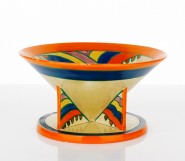Lot #10 - Rover Thomas (Joolama)
-
Auction House:Deutscher and Hackett
-
Sale Name:The Laverty Collection Part III
-
Sale Date:05 Apr 2017 ~ 7pm
-
Lot #:10
-
Lot Description:Rover Thomas (Joolama)
(c.1926 – 1998)
Djugamerri And Bolgumerri, 1991
natural earth pigments and gum on linen
89.5 x 110.0 cm
bears inscription verso: artist’s name, title and date
RELATED WORK: Dumorunji, 1986, earth pigments and natural binders on plywood, 60.7 x 90.8 cm, Holmes à Court Collection, Perth, reproduced in. Carrigan, B., (ed.), Rover Thomas: I want to paint, Heytesbury Pty Ltd, Perth, 2003, pl. 2, p. 66 (illus.) -
Provenance:Commissioned by Mary Macha, Perth (inscribed verso) ; Private collection, Western Australia; Mary Macha, Perth; The Collection of Colin and Elizabeth Laverty, Sydney, acquired from the above in October 2003
-
Exhibited:Laverty 2, Newcastle Region Art Gallery, New South Wales, 14 May – 14 August 2011
-
References:Beyond Sacred: Recent Painting from Australia’s Remote Aboriginal Communities: The Collection of Colin and Elizabeth Laverty, Hardie Grant Books, Melbourne, 2008, pp. 3 (illus.), 202 (illus.) ; Beyond Sacred: Recent Painting from Australia’s Remote Aboriginal Communities: The Collection of Colin and Elizabeth Laverty, edition II, Kleimeyer Industries Pty Ltd, Melbourne, 2011, p. 214 (illus.)
-
Notes:This painting is accompanied by notes and an annotated diagram from Mary Macha, Perth. ‘Light flooded.’ This is how Vivien Johnson described Makinti Napanangka’s first paintings after she had cataracts removed from her eyes in 1999.1 Makinti had initially commenced painting in 1994 at Haasts Bluff and she was among the small group of female artists who participated in the Minyma Tjukurrpa, Kintore/Haasts Bluff canvas project in 1995, an exhibition that heralded the beginnings of the women’s painting movement through Papunya Tula Artists cooperative.2 But she came into her own in 2000 with her first solo exhibition at Utopia Art Sydney, aptly entitled New Vision, an allusion to her restored eyesight, but also perhaps to the freshness of a body of paintings radiant with golden light. The Sydney Olympic year also saw her inclusion in the benchmark exhibition Papunya Tula: Genesis and Genius at the Art Gallery of New South Wales with a painting of the same subject from the same year. In Kungka Kutjarra (Two Women), 2000, Makinti Napanangka combines graphic motifs that dominated her earlier paintings–series of outlined circular forms, here denoting rockholes – with the bands of parallel arcs that became the hallmark of her later work. The rockholes were formed by Kungka Kutjarra, two ancestral women, at a site south of Lake MacDonald while digging for Kuningka, the Western Quoll. The bands represent the strands of spun hair string that make up the nyimparra or skirts worn by women in ceremony. The tactility of the paint in this picture suggests the practice of drawing in the sand to a narrative accompaniment, and the rhythms of the bands of arcs echo the sway of the skirts as women dance. 1. Johnson, V., Lives of the Papunya Tula Artists, IAD Press, Alice Springs, 2008, p. 316 2. Exhibited at Tandanya National Aboriginal Cultural Institute, Adelaide WALLY CARUANA
-
Estimate:A$220,000 - 300,000
-
Realised Price:
-
Category:Art
This Sale has been held and this item is no longer available. Details are provided for information purposes only.










